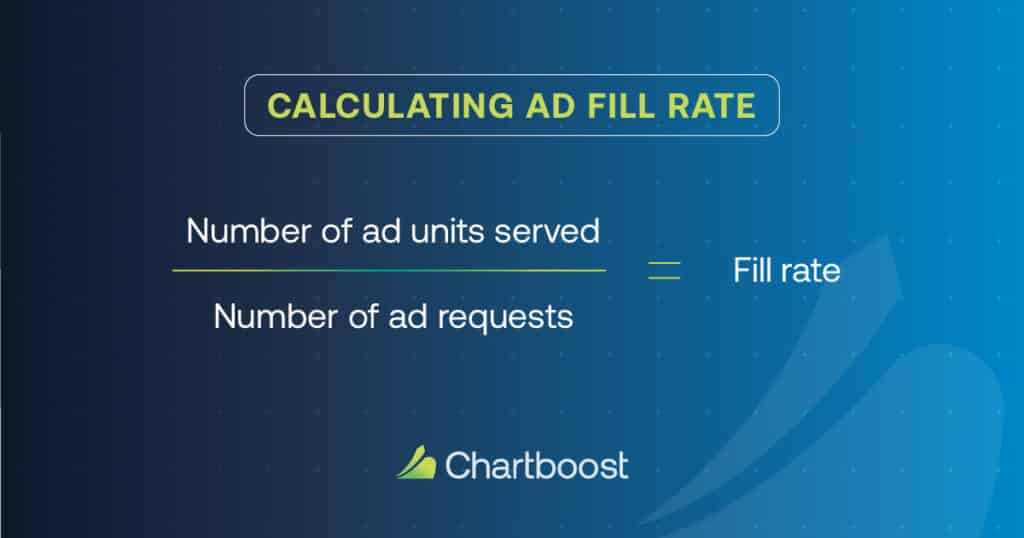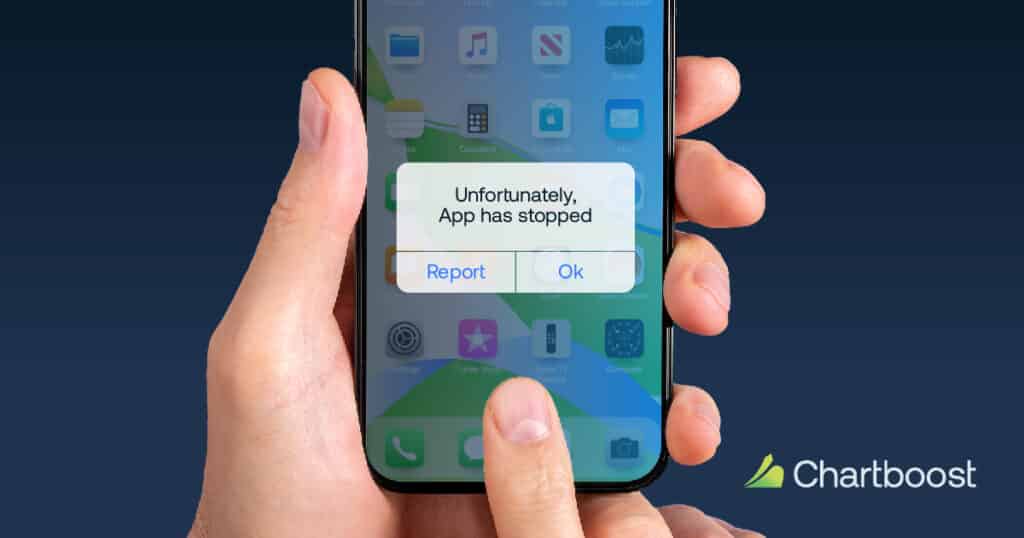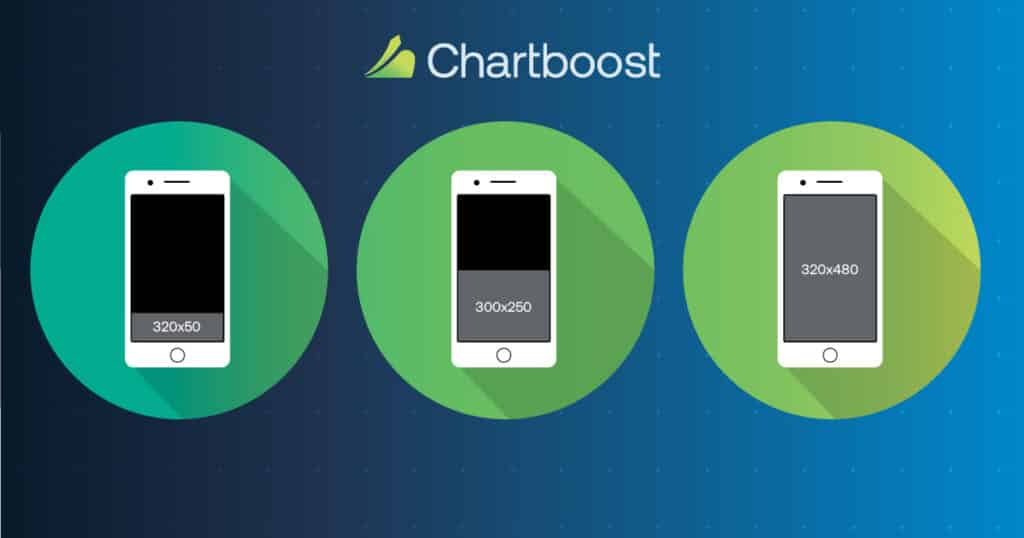It was once pondered, “Why do you build me up, just to let me down?” Well buttercup, it turns out mobile game publishers often wonder the same thing when it comes to ad fill rate.
Fill rate is an ad metric that measures how well an ad network is performing, allowing you to measure the efficiency of your ads. Fill rates help you better understand profitability.
When thinking of fill rates, Jeff Carlson, Head of Publisher Products at Chartboost, suggests asking yourself the following questions: “What markets is my game serving? And how do I want to monetize those users?”
He explains, “You must have a stable ad platform. If your app is crashing, you monetize zero percent of that inventory. You can’t fill an ad on an app that’s crashed.”
Before going in-depth about why your fill rate isn’t at 100 percent, we’ll first cover what a fill rate is and why it matters when it comes to monetization.
What is a fill rate?
When a user visits a mobile game with in-app advertising, an ad request is sent to the publisher. The ad request can then be filled with an ad (or not; we explain further below). The percentage of ad requests that are successfully delivered is called the fill rate.
The fill rate divides the number of ad units served by the number of ad requests sent to the server.

What a low fill rate means
A low fill rate means only a small percentage of ad requests are fulfilled with advertisements. If you notice your fill rate is low or has decreased recently, you should take steps to figure out what could be affecting it.
Here are some factors that can affect ad fill rate:
- Ad inventory: The type and quality of ad inventory that a publisher has can affect the fill rate. For example, if your available ad space is premium, you’re more likely to have a higher fill rate.
- Ad network: The ad networks you use can also affect fill rates. Some ad networks have better relationships with certain advertisers, which can lead to higher fill rates.
- Technical errors: Technical errors, such as long load times or ad incompatibility, can also impact the fill rate.
What is considered a “good” fill rate?
Generally speaking, the higher the fill rate percentage, the better. A strong fill rate indicates that the ad network is showing ads to users at a high rate, which should lead to more ad revenue.
Carlson believes getting to a fill rate close to 100% can be achieved if you’re backfilling your ads with cross-promotional campaigns. “It’s a matter of what demand sources you’ve connected to your waterfall and how many times you want to show ads that you own and control when no other demand source wants to fill it.”
However, Carlson notes, “You will never hit 100% fill rate. You could get close, but it’s difficult due to user activity, such as closing the game, or maybe the game crashes while acting on a request. If the app closes, you’ll never actually register a potential ad for that particular opportunity.”
In other words, measuring your fill rate by how close you can get to 100% isn’t the way to think about this metric.
Carlson explains further. “Let’s say I have a 100% fill rate. Those are ads successfully loaded over the ads requested. Done. But if I’ve only shown one to the user, I’m not being very efficient at using those fill rates. Instead, ask yourself how many ads do you have that are returned — which is your ultimate opportunity. How many of those were you able to show to the end user?”
Visibility vs. viewability and effectiveness of your ads
There can be many reasons why your fill rate differs from where you want it to be. Carlson says, “There’s a small nuance in ad tech that’s super important to understand: the difference between visibility and viewability.”
These two factors reveal the effectiveness of your ad inventory:
- Visibility: Whether the ad was shown on screen
- Viewability: The length of time and how much of the ad was shown
To help you better understand, this is how visibility and viewability fit in the ad request flow:
- An ad request is made
- A response comes from the network
- The ad loaded successfully and is then made visible (visibility)
- Length of time the ad was viewable and whether the ad was obstructed or not (viewability)
Carlson concludes, “Fill rates are vital overall metrics. But how effective are you at actually utilizing those ads on screen?”
Reasons the effectiveness of your ads are falling short
There are many reasons why your ads aren’t effective, hindering their ability to achieve a high fill rate. Here are the common main causes:

User issues and errors
User devices and operating systems, what other apps they have running, and the memory on those devices may affect how your ad performs.
Carlson says, “Games generally aren’t always optimized to allocate space for their game and additional processes that run alongside it. This is where you can run into memory issues.”
This may cause the ads to freeze. “It’s sort of like trying to contain an explosion by shutting it down.”
Other user-related problems are network errors on the user’s side that keep the ad from delivering properly. For example, if a user suddenly loses a WiFi signal, your ad network can’t serve the ad.
How to address it
To help alleviate some of these challenges, partner with a stable ad network that can address problems that deal with memory and internet issues. Choosing one that constantly updates its SDKs to minimize technical errors is important.
Many ad networks provide tools and features that allow you to be more precise and address errors to improve your ad effectiveness.
Carlson states, “Apps can crash, whether it’s other SDKs, platforms, user devices, or programming.”
Chartboost is a developer-focused ad network that takes the additional step of adding stability. We provide a variety of options for publishers to control when and where certain pieces of the mediation layer can be turned on or off. Let’s say a particular network crashes on a subset of devices, say, Android 5.0 in Vietnam. Chartboost can turn off that particular network that’s crashing while keeping everything else on.
“This prevents the entire system from ‘blowing up,’ which is good.”
In other words, it is extremely useful to be able to turn off any bad parts yet continue to monetize as usual for everything else.
Put another way, you wouldn’t scrap your whole car if you only had a scratch on the door. For mobile ad monetization, publishers should feel empowered with precise tools that unlock their ability to retain a higher fill rate.
Page latency
Latency is the time it takes for data to travel from one place to another. Ads can load slowly or not at all when there’s a lot of latency.
This can lead to lower fill rates, which means advertisers may not be willing to pay for ad space that users don’t see. Latency can slow down ads and hurt your bottom line.
How to address it
To improve your page latency:
Use a content delivery network (CDN): A geographically distributed network of servers that provide high availability and performance by distributing the service to users within a certain location. Some well-known CDNs include Edgecast, Fastly, and Cloudflare.
Optimize your images: Reduce large image file sizes or scale back on the number of high-resolution images.
Minify your code: Minification is when you eliminate unnecessary code, such as removing whitespace and comments, resulting in a smaller file size.
Use a tool: There are plenty out there to check page latency, but you could start with Google PageSpeed Insights or Lighthouse.
High floor prices
Floor prices refer to the minimum price set for the ad inventory by a publisher. Anything below this price won’t be sold, so setting the price too high can create unfilled impressions.
How to address it
If the platform you use includes automatic floor price adjustments, you can find the balance of a floor price that works without leaving too many unfilled impressions. For example, you could set the floor prices to automatically adjust by geos, unit, and device type.
Using one ad network
If you only use one ad network, you’re stunting your ability to fulfill ads more effectively.
How to address it
Rather than putting all of your ad efforts into one network, use several. A few different ad networks are better than one because if a network fails to fill an ad request, you have another that can.
You can also keep tabs on how each ad network performs and compare and contrast.
Ad fraud
A recent report revealed that 15% of global media spend is wasted on ad fraud. It’s also estimated to cost the industry $100 billion.
This misuse of ad platforms that generate clicks and impressions causes a reduction in fill rates and increased costs for you. It may also deter your ability to attract new advertisers and users.
How to address it
Fraud detection tools provided by your ad network help identify and block fraudulent clicks and impressions. This is another reason why it’s important to work with reputable ad networks that offer faster and more effective methods for detecting fraud in real-time and implementing immediate solutions. Chartboost’s App-ads.txt Verifier, for instance, ensures bid requests only come from authorized sellers.
Whatever ad networks you choose, make sure they address ad fraud. A fraud detection company can also inform you of fake clicks and installs.
Best practices for minimizing bugs and maximizing fill rates
Some things within your control can get you closer to achieving your fill rate goals. Here are best practices to consider:

Provide multiple ad formats: Use different ad sizes to ensure your ads fit and render properly on different user devices. Advertisers are more likely to fill your ad slots if they know they can choose from various sizes. For example, you might prefer a 300×600 ad size because your data shows that it has the highest click-through rate (CTR). But you could also use a backup size, such as 300×250, to increase your chances of filling that slot.
Find the right balance for your supply: Use ad mediation (aka header bidding) to make your inventory available to multiple ad networks simultaneously. This helps increase competition for ad placements. Track the fill rates from various demand partners by analyzing the bid and win rates at the auction.
Optimize location-based targeting: Through your ad network, determine which countries bring you traffic and whose audiences are willing to spend. Then geo-target your ads to those areas for maximum potential for ads to be shown to them and increase your ad fill rate.
Ad placement: Consider changing ad placement to increase visibility and user engagement, such as above the fold or near engaging content.
Limit how often your ads refresh: Restrict your ad refresh rate to at least 30s to increase your ad fill rate and CPMs.
Final thoughts
It’s a lucrative time to be in the mobile space. Consumers are spending an average of 5.5 hours on their phones in 2023, and by 2027, the mobile ad space is expected to expand by 6.95%.
This continued growth means heightened competition, so stay on top of your ad monetization strategies and fill rates.
Taking steps to improve your ad fill rate means you’re identifying areas for improvement and optimizing your ad inventory. Ensure it’s relevant and targeted to the right audience, use multiple ad networks, and closely monitor your fill rate.
Pay attention to the overall viewability of your ads and the ad verification process. Make sure your ad tech functions properly. Finally, partner with well-established ad networks and put your potential risks of losing revenue at the forefront.



